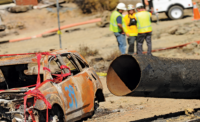Keystone XL Pipeline
The new measure goes on the books at a time when pipelines are in the spotlight, with much of the attention focused on TransCanada’s planned Keystone XL crude-oil pipeline.
Advocates say the $7-billion project, which would run from Alberta to Texas, would be a major source of new jobs, including thousands in construction, and provide a source of energy from Canada, a longtime U.S. ally.
But environmentalists contend the project will do serious ecological damage.
Congress has directed the Obama administration to decide by late February whether to permit the project to go forward.
One provision in the new statute would apply to the Keystone XL project. It would require DOT to produce a review of federal rules to see if they are adequate for regulating those carrying “diluted bitumen,” which the Sierra Club’s Moffitt says is the main product that would pass through the Keystone XL pipeline. But the law goes no further than mandating the study.
Terry Cunha, a TransCanada spokesperson, says the company commends Congress and DOT for “seeing this important piece of legislation enacted.” As PHMSA implements the measure and works on its studies, TransCanada looks forward to an active role in supporting improvements to pipeline infrastructure, Cunha adds.
Cunha says, “However, at the moment, it’s too premature to speculate as to what the outcome of these studies will be and what the ultimate impact to TransCanada will be.”
While the Sierra Club is happy to see the bitumen study in the final version, Moffitt says provisions dealing with disclosure requirements—such as making documents regarding spill-response plans publicly available—are “actually a step backward” and would make it more difficult to file lawsuits challenging the adequacy of response plans.
Pressure Tests
One provision that could have expensive consequences for industry requires PHMSA to issue regulations within 18 months mandating tests to confirm the strength of certain previously untested natural-gas pipelines.
It would apply to pipelines that are located in heavily populated, environmentally sensitive or other “high-consequence areas” and operating at a pressure more than 30% of their specified maximum-yield strength.
But the law doesn’t specify the type of pressure test to be required. One option is hydrostatic tests, which INGAA's Landry says “can run from $250,000 to about $500,000 per mile.”
The statute also doesn’t set a deadline for firms to carry out the unspecified pressure test. It says the testing period should take into account potential public-safety and environmental impacts and also “minimize costs and service disruptions.”
Similarly, the legislation directs DOT to study whether current integrity-management programs, which now apply to pipelines in high-consequence areas, should cover other pipelines. The programs include procedures for identifying, evaluating, fixing and validating a pipeline's integrity.
DOT has two years to finish that report; if it finds a regulation is needed, it has about another year to issue it. But if DOT finds an “imminent hazard,” the department could issue a rule sooner to address it.



